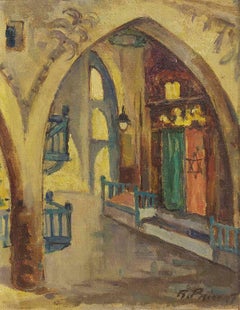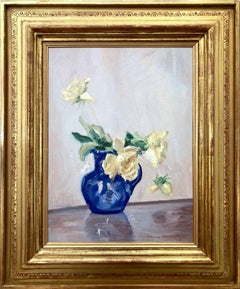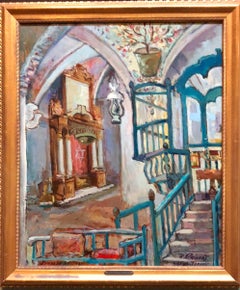Raphael Pricert Interior Paintings
to
1
Overall Width
to
Overall Height
to
1
1
1
1
1
1
1
1
1
1
184
64
56
41
1
Artist: Raphael Pricert
Old Synagogue in Safed Israel
By Raphael Pricert
Located in Surfside, FL
Framed Judaica oil painting of architecture interior of synagogue in Tzfat, Safed, Israel: by Raphaël Pricert. Born in 1903, Raphael Pricert is a listed Russian born Impressionist pa...
Category
20th Century Raphael Pricert Interior Paintings
Materials
Oil
Related Items
"White Roses in Blue Vase" Still Life Impressionist Oil Painting on Canvas Board
By Johann Berthelsen, 1883-1972
Located in New York, NY
A stunning jewel and pertinent example of Berthelsen's charming Still Life scenes. Here we find a white roses in a blue vase set on top of a glossy table. The artist was truly a mast...
Category
Mid-20th Century American Impressionist Raphael Pricert Interior Paintings
Materials
Canvas, Oil, Board
Sea. Sailboat.
Located in Zofingen, AG
In this piece, I sought to capture the serene dance between sky and sea, interspersed with the graceful ballet of a sailboat. Infused with the essence of expressionism and the delica...
Category
2010s Expressionist Raphael Pricert Interior Paintings
Materials
Canvas, Oil, Cardboard, Giclée
Giambattista Piazzetta workshop (Italian master) - 18th century figure painting
Located in Varmo, IT
Circle of Giambattista Piazzetta (Venice 1683 - Venice 1754) - San Giacomo Maggiore.
62.5 x 52.5 cm without frame, 72.5 x 62.5 cm with frame.
Antique oil painting on canvas, in a c...
Category
Mid-18th Century Rococo Raphael Pricert Interior Paintings
Materials
Canvas, Oil
$2,127 Sale Price
28% Off
H 28.55 in W 24.61 in
Dandelions
Located in Zofingen, AG
In this artwork, I've aimed to capture the transient beauty of nature, an expression of life's fleeting moments. Employing gentle strokes and a harmonious palette, I convey the delic...
Category
2010s Expressionist Raphael Pricert Interior Paintings
Materials
Oil, Giclée, Cardboard, Canvas
"Window on the city" Oil cm. 134 x 126, 1968
By Maya KOPITZEVA
Located in Torino, IT
Open window to the city in spring, light, roofs, City, Interior
MAYA KOPITZEVA (Gagra, Georgia, 1924 - 2005)
Maya kopitzeva’s works have been acquired by the Russian Ministry of ...
Category
1960s Post-Impressionist Raphael Pricert Interior Paintings
Materials
Canvas, Oil
Scarlet Sails
Located in Zofingen, AG
As an artist, I poured my spirit into this artwork, invoking the raw feelings of freedom and adventure with each stroke. The vivid hues emanate a sense of hope and endless possibilit...
Category
2010s Expressionist Raphael Pricert Interior Paintings
Materials
Canvas, Oil, Cardboard, Giclée
Vintage Italian Modernist Impressionist Hydrangea Still Life By P.Russo
Located in Douglas Manor, NY
6010 Vintage Modernist Impressionist still life hydrangea bouquet in a torquoise vase, oil on canvas signed by P.Russo
Unframed
Category
1980s Raphael Pricert Interior Paintings
Materials
Oil
$300
H 24 in W 18 in D 1 in
Giambattista Piazzetta workshop (Italian master) - 18th century figure painting
Located in Varmo, IT
Circle of Giambattista Piazzetta (Venice 1683 - Venice 1754) - San Tommaso.
62.5 x 52.5 cm without frame, 72.5 x 62.5 cm with frame.
Antique oil painting on canvas, in a contempora...
Category
Mid-18th Century Rococo Raphael Pricert Interior Paintings
Materials
Canvas, Oil
$2,152 Sale Price
28% Off
H 28.55 in W 24.61 in
Mid Century Modern Swedish Interior Still Life Oil Painting - The Striped Cloth
Located in Bristol, GB
THE STRIPED CLOTH
Size: 49.5 x 38 cm (including frame)
Oil on canvas
An vibrant mid-century interior still life painting, executed in oil onto canvas.
The composition presents a w...
Category
Mid-20th Century Modern Raphael Pricert Interior Paintings
Materials
Canvas, Oil
$984
H 19.49 in W 14.97 in
J J A Lecomte du Nouÿ (1842-1923) An oriental street, oil sketch
By Jean-Jules-Antoine Lecomte du Nouÿ
Located in Paris, FR
Jean-Jules-Antoine Lecomte du Nouÿ (1842-1923)
An oriental street
oil on canvas
11.5 x 14 cm
no signature
In good condition, canvas without stretcher,...
Category
1890s Romantic Raphael Pricert Interior Paintings
Materials
Oil
$1,070
H 4.53 in W 5.52 in
In a hotel room. Venice
Located in Oslo, NO
The idea for this work arose on the author's birthday, when he specially came to Venice to celebrate it there. In the painting we see the interior of a hotel room with evening Venice...
Category
2010s Realist Raphael Pricert Interior Paintings
Materials
Canvas, Oil
P Deltour (?), An artist and his models in the workshop, 1879, oil on canvas
Located in Paris, FR
P Deltour (?) French school of the 19th century
The artist with his model and friend in his workshop
Oil on canvas
Signed "P Deltour" (?) and dated 1879 on the lower, an indistinct i...
Category
1870s Romantic Raphael Pricert Interior Paintings
Materials
Oil
$1,506
H 24.02 in W 19.69 in
Previously Available Items
French Israeli Judaica Oil painting Old Synagogue Interior in Safed Israel
By Raphael Pricert
Located in Surfside, FL
Framed Judaica oil painting of architecture interior of synagogue in Tzfat, Safed, Israel by Raphaël Pricert. synagogue interior 'Abuhav Synagogue' Safed.
Born in 1903, Raphael Pri...
Category
20th Century Post-Impressionist Raphael Pricert Interior Paintings
Materials
Oil
French Israeli Judaica Oil painting Old Synagogue Interior in Safed Israel
By Raphael Pricert
Located in Surfside, FL
Framed Judaica oil painting of architecture interior of synagogue in Tzfat, Safed, Israel by Raphaël Pricert. synagogue interior 'Abuhav Synagogue' Safed.
Born in 1903, Raphael Pricert is a listed Russian born Impressionist painter who trained in Bucharest, Odessa, Italy and Paris. His works were exhibited widely in Europe as well as in the United States. In San Francisco, he was represented by the prestigious Maxwell Galleries. He died in 1967.
Born in Balta (Russia) December 19, 1905 into a well-to-do family of grain dealers in Crimea.
In 1918 his father sends him to study drawing and painting with Maître Ilya Bersetski in Odessa.
In 1919 the Pricert family were forced by the October Revolution to leave Russia and escaped to Romania. Raphael Pricert pursues his artistic studies in the Art School of Bucharest.
In 1923 Raphael Pricert went to Florence to study at the Florence Art Academy with Bastianini, Trentacosta, Felice Carena etc.
In 1928 he wins the second prize of the Florence Academy of Arts and then returns to his family in Bucharest, Roumania. In 1929 a Russian theatre company stages a play by Chekov in Bucharest. He spends his evenings in the theatre wings, drawing the portraits of the actors, and soon becomes their friend. During his stay in this city he takes part in an exhibition and decides to give up the material security his family offers him, to dedicate himself to art. He moves to Zurich – Switzerland, where he finds he can make a living from drawing for advertising. He also spends much time drawing and painting. 1929, Raphael Pricert goes to Paris, the world capital of creativity and artistic freedom, attracted as so many artists of his time by the radiance of the Ecole de Paris which had attracted to the Montparnasse district the most cosmopolitan and advanced culture of Europe from the turn of the century. In 1930 he is back in Zurich for a few months and organizes at the Actuarius gallery an exhibition of the works he had left behind with various friends. The interest shown in this exhibition confirms his decision to dedicate his life to painting, and to settle down in this unequalled artistic centre which is the Paris of those days. He moves to a small studio Place de la Sorbonne where he lives until he gets married in 1935. He goes to the Free Academies, ‘Atelier Julian’ and ‘Grande Chaumière’ Every evening in Montparnasse on the corner of Vavin, he meets up with painters and sculptors from all parts of the world : Russian, Polish, and also Italian… There he meets Benn and Mane-Katz who eventually become his close friends. He draws characters in the Cafes : the Dome, the Select and the Coupole.
In 1932 Antonio Aniante, a political journalist and writer, who owns a gallery/bookshop on rue Vavin, chooses him to represent the hopes of the new Europe along with other artists who are also hardly known such as Filippo de Pisis, Giorgio de Chirico, Oskar Kokoschka and Kostia Terechkovitch. In 1934 Raphael Pricert takes part in the exhibition of the Independent Artists and also organizes another exhibition in Caen. Antonio Aniante prefaces this latter exhibition with these warm words "I had the privilege of presenting his works for the first time in Paris along with the recent paintings of Tozzi, Kokoshka and Coubine who represent the finest examples of the French School of Painting. I can state without exaggeration that he belongs to the greatest artists of this new generation". He presents oils, watercolors and drawings : portraits and views of Old Paris, Italy and Switzerland. The interest raised by his works is so great that he is selected by the Jury of the Salon des Tuileries, where he later exhibited that same year.
1943 : Having escaped the Gestapo by miracle, he manages to find paints and canvases to continue his drawing and painting, travelling around the region, painting numerous landscapes, modest homes and portraits of humble and picturesque people.
1944-1946 : shortly after the Liberation, he exhibits his paintings in Vixouze, Polminhac, Vic-sur-Cère and Aurillac – sponsored by the National Intellectual Committee. In spite of the difficulties and shortages of those times, he gains a reputation in this beautiful region of France. Well-to-do and even more modest people want to buy his works.
From September 21st to October 5, 1946 the Gallery Giraudo on Avenue de l’Opera in Paris puts on an exhibition of his Auvergne paintings. This exhibition was a success and it was warmly praised in the art press.
He reappears in the Salon des Tuileries in 1946 with two of his Auvergne paintings : the ‘Auvergne tramp’ and the ‘Old Salers’, and he later exhibits several canvases and watercolors at the Hotel de Bordeaux in Aurillac from December 17 to December 30, 1946.
In May 1947, Raphael Pricert and his wife acquire French nationality. He returns to the Auvergne and exhibits his Auvergne works at the Galerie de la Cité in May 1947, at the Chamber of Commerce of Aurillac in February 1949, at the third Salon des Beaux Arts et lettres of the Massif Central region, and on the Faubourg Saint Honoré in Paris from February 25 to March 15, 1950.
From 1947 he is insearch of new inspiration : in Belgium at a joint exhibition, in the summer on the Côte d’Azur and in Corsica, in Italy, in Venice, Florence and Rome to which he returned frequently as of 1948, and of course always Paris.
From end 1947 to January 3, 1948, he puts on a exhibition in Paris, rue La Boetie at the Gallery Cambaceres, where he shows his paintings of Bruges and Corsica.
In 1948, his cousin Irving, long lost since the First World War, and who since then settled in New York, comes to hear about him. An American journalist contacted him to find out if he knew of a certain Raphael Pricert, the painter of a painting he purchased in Berlin, and at the back of which was the address of rue Besnard in Paris. Irving came over to Paris to find his cousin, and this is how he was introduced to a Gallery in New York the Associated American Artists .
In 1949 Raphael Pricert goes to the United States. From June 6 to June 25, he exhibits at the Associated American Artists with twenty five paintings in the two large rooms he is allocated. He receives collectors, happy to discover a painter of the French School. He is given orders for portraits. With four of his paintings, he enters the collection Nathan Cummings.
In 1952 Abe Saperstein, the director of the Harlem Globe-trotters, the famous American basketball team, meets him in Paris and visits his artist studio.He orders his own portrait as well as the portraits of all the players in his team. He is enthusiastic and invites him to exhibit in Chicago, promising to introduce him to the best art galleries.
In 1953 Raphael Pricert returns to the USA in March to have an exhibition at the Gallery Frank J. Oelschlaeger. The day before the ‘vernissage’ (opening), he writes to his wife who had remained in Paris, that he has already received orders, and that the exhibition looks promising. He displays about 40 paintings of France, Italy, Spain along with a few water colours. He enjoys immediate success. His catalogue listing is covered with sold signs. The Chicago Daily Tribune writes three articles about Raphael Pricert and he is also interviewed on television. He is fascinated by Venice. In 1959 he tells a journalist who is interviewing him, that he has been to Italy 17 times.
In 1954, he returns to the USA : In February he exhibits in Saint Louis (Missouri) at the Noonan-Kocian Gallery, and the Missouri Athletic Sports Club buys one of his large Montmartre paintings.
The businessman David Freeman who becomes a close friend, buys a very large painting of Piazza San Marco in Venice. In April and May, he is a Los Angeles at the Gallery Francis Lynch, to show landscapes and compositions, along with a large series of portraits of Hollywood stars, from Terry Moore...
Category
20th Century Post-Impressionist Raphael Pricert Interior Paintings
Materials
Oil
Old Synagogue in Safed Israel
By Raphael Pricert
Located in Surfside, FL
Framed Judaica oil painting of architecture interior of synagogue in Tzfat, Safed, Israel: by Raphaël Pricert. Born in 1903, Raphael Pricert is a listed Russian born Impressionist pa...
Category
20th Century Raphael Pricert Interior Paintings
Materials
Oil
Raphael Pricert interior paintings for sale on 1stDibs.
Find a wide variety of authentic Raphael Pricert interior paintings available for sale on 1stDibs. You can also browse by medium to find art by Raphael Pricert in oil paint, paint and more. Much of the original work by this artist or collective was created during the 20th century and is mostly associated with the Post-Impressionist style. Not every interior allows for large Raphael Pricert interior paintings, so small editions measuring 18 inches across are available. Customers who are interested in this artist might also find the work of Jacques Martin-Ferrières, Rafael Duran Benet, and Jacques Zucker. Raphael Pricert interior paintings prices can differ depending upon medium, time period and other attributes. On 1stDibs, the price for these items starts at $1,250 and tops out at $3,600, while the average work can sell for $2,425.



